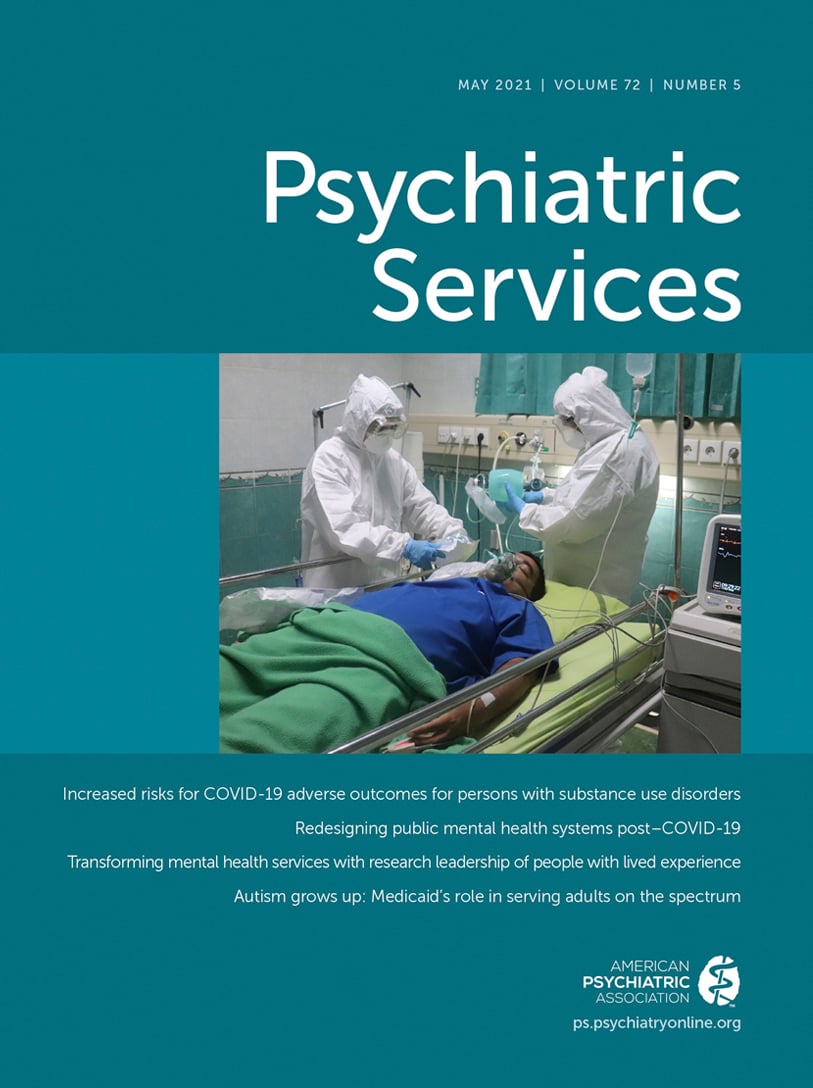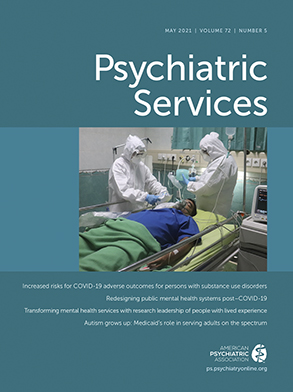Compared with the general population, people with serious mental illness (e.g., schizophrenia) continue to have reduced life expectancy because of higher rates of obesity, type 2 diabetes, and cardiovascular disease (CVD) (
1). Belonging to a racial-ethnic minority group exacerbates these health inequities. Hispanics and Blacks with serious mental illness have elevated risk of obesity and type 2 diabetes, compared with non-Hispanic Whites with serious mental illness (
2,
3). Reducing obesity among persons with these mental health conditions, particularly in racial-ethnic minority groups, is important for improving the health of these historically underserved populations.
Clinical trials based in the United States have shown that lifestyle interventions that increase healthy dietary habits and physical activity can improve general health of individuals with serious mental illness through weight reduction and improved cardiorespiratory fitness (CRF)—that is, the circulatory and respiratory systems’ ability to supply oxygen to working muscles during physical activity (
4–
7). Despite these results, several knowledge gaps remain. First, these trials used clinical staff in interventions, limiting the workforce that can deliver these interventions. The use of peer specialists, that is, people with lived experience of serious mental illness, to deliver healthy lifestyle interventions is a promising approach to increase the reach of these interventions, because peer specialists are a growing workforce in the United States (
8). Rigorous studies are needed to test the effect of peer-led interventions on the health of people with serious mental illness (
9). Second, these trials were conducted in clinical settings (e.g., outpatient clinics), restricting the accessibility of the interventions. Moving interventions closer to the community by delivering them in supportive housing agencies can help address access barriers by bringing interventions to “people’s doorsteps” (
10). Supportive housing programs are an important setting for people with serious mental illness because they provide general medical, mental health, and social services (
11). Finally, persons with serious mental illness from racial-ethnic minority groups are underrepresented in existing trials. However, two recent trials have actively recruited persons from racial-ethnic minority groups: 46% of participants in the InShape Replication trial (
5) were largely Black and Hispanic, and 38% of ACHIEVE trial participants were Black (
6).
To further close these gaps, we conducted a hybrid type 1 trial to pragmatically examine the implementation and test the effectiveness of a 12-month program, the Peer-led Group Lifestyle Balance (PGLB) intervention, in a sample comprising persons with serious mental illness predominantly from racial-ethnic minority groups who were overweight or obese (body mass index [BMI] ≥25) and living in supportive housing. This design tested the effectiveness of the intervention while collecting data about the intervention’s potential for community implementation (
12). Here, we present results for our main effectiveness outcome, clinically significant weight loss, and our secondary outcomes, clinically significant improvements in CRF and reductions in CVD risk. We hypothesized that significantly larger proportions of PGLB participants, compared with participants receiving usual care, would achieve clinically significant weight loss, improved CRF, and reduced CVD risk at 12 and 18 months postrandomization, regardless of study site.
Discussion
Our findings did not support our hypothesis. Although a larger proportion of participants in the PGLB group achieved clinically significant weight loss, increases in CRF, and reductions in CVD risk at 12 and 18 months, compared with usual care, differences between groups were not statistically significant. PGLB’s impact, relative to that of usual care, differed by study site.
These null findings do not appear to be a result of PGLB underperformance. Instead, our results indicate that PGLB achieved outcomes comparable to those from other U.S.-based healthy lifestyle trials involving people with serious mental illness (
5–
7) and those reported in a recent meta-analysis (
23). The ACHIEVE trial tested the effectiveness of an 18-month behavioral weight-loss intervention for people with serious mental illness in psychiatric rehabilitation programs (
6). ACHIEVE was associated with clinically significant weight loss for 32.5% of participants at 12 months and 37.8% at 18 months (
6), comparable to the 29% and 32%, respectively, for these time points in the present study. The InShape trial tested the effectiveness of a 12-month health promotion program consisting of individualized sessions with a health coach and free gym memberships (
5). InShape was associated with clinically significant reductions in CVD risk for 51% of participants at 12 months and 46% at 18 months (
5), similar to the 48% and 49%, respectively, for the same outcome and time points among PGLB participants in our study. Our findings suggest that PGLB delivered in supportive housing can produce clinically significant health improvements in racially and ethnically diverse samples of persons with serious mental illness that are consistent with the outcomes of other non–peer-led healthy lifestyle interventions.
The lack of significant differences between the PGLB and usual care groups in the outcomes of the present study indicates that several methodological and contextual factors need to be considered. The imbalance at baseline between our two groups in weight—an average lower weight of 14 pounds for the usual care group—suggests that PGLB participants needed to achieve greater weight loss than those receiving usual care to counteract this difference. Although we corrected for this imbalance in our analyses, the PGLB group, on average, still did not achieve greater weight loss than the usual care group.
The use of usual care services for support of general medical health at our study sites might have increased during the study period, with more use among persons in the usual care group, thus influencing their weight loss, CRF, and CVD risk reduction outcomes. Our data do not support this pattern, because we observed no differential use of usual care services between groups, and the use of usual care decreased throughout the trial for both groups (see online supplement).
We noted improvements in study outcomes for the usual care group during the trial, which mirrored improvements in the PGLB group, suggesting that some usual care participants engaged in weight-loss strategies. Contamination between groups could account for these improvements in the usual care group, because we randomized at the participant level because of the small number of study sites. A potential source of contamination was the PGLB peer specialists, who were employees of the supportive housing agencies. However, we note that PGLB peer specialists’ sole responsibility was to deliver PGLB to participants randomly assigned to the intervention, and they had little contact with usual care participants.
Another source of contamination could have been interactions throughout the trial between PGLB and usual care participants, leading to sharing of PGLB materials and strategies for weight loss, thereby activating usual care participants to lose weight. To check for contamination, we used a six-item self-report measure asking all participants at 6, 12, and 18 months whether they engaged in PGLB strategies. On average, PGLB participants reported significantly greater engagement in PGLB strategies throughout the trial than did usual care participants (see table in
online supplement). However, >40% of usual care participants reported engaging in PGLB strategies, particularly tracking their eating and exercise, and setting weight and exercise goals. Although this may have influenced our findings, it suggests that elements of PGLB resonated with participants to the point of their possibly sharing materials and strategies with usual care participants. A social proliferation process may have occurred whereby PGLB participants shared their new knowledge with their social circles within these agencies, helping diffuse PGLB strategies and activating usual care participants to engage in healthy lifestyle changes (
24). More research is needed to better understand how this social proliferation process may have unfolded and to evaluate its impact on helping participants achieve clinically significant changes in weight and CRF.
Losing weight and improving CRF are major challenges for people with serious mental illness who are overweight or obese (
25). Effective interventions use intensive manualized programs that combine coached and structured physical activity, support dietary changes with behavioral techniques, and last >9 months (
26). Our null findings suggest that for some participants enrolling in a weight-loss study and having their weight, CRF, and other health indicators assessed every 6 months, and potentially learning about PGLB from other participants, may have activated them to lose weight and improve their CRF. A similar finding was reported in a small study of patients from a Hispanic background who attributed their weight loss at 40 weeks after baseline to regular weight checkups by staff, which increased their attention to weight-related issues (
27). A one-size-fits-all healthy lifestyle approach may not be the most efficient way to help people with serious mental illness. Personalized strategies tailored to an individual’s characteristics, needs, and preferences may be needed for persons with serious mental illness; some may require intensive and structured behavioral approaches, whereas others may need fewer strategies, such as frequent weight monitoring and goal setting.
PGLB benefits were not uniform across the three study sites. At site 3, PGLB consistently outperformed usual care. This site included 40% of PGLB participants but accounted for more than half of the participants who achieved clinically significant weight loss (51%), improved CRF (68%), and reduced CVD risk (55%) at 18 months. We know of no published effectiveness trial of healthy lifestyle interventions for people with serious mental illness that has reported or examined site differences. More in-depth analyses of the qualitative and quantitative data collected as part of our hybrid trial are required to examine possible heterogeneity among sites, including whether potential differences in fidelity to the intervention, staff turnover, participants’ experiences with PGLB, or other contextual factors could explain these site differences. We are in the process of conducting these analyses and plan to publish their results in the future. This exploration may uncover contextual and implementation factors that are necessary to identify how and why PGLB works in certain settings and not others and that can inform the development of implementation strategies for PGLB (
28,
29). More studies are needed, because little is known about the type of implementation strategies that can support adoption of healthy lifestyle interventions for people with serious mental illness in routine practice settings.
Our trial had several limitations. Because of logistical constraints, we did not use assessors blinded to participants’ group assignment (PGLB vs. usual care) to measure study outcomes, which could have biased study assessments. We conducted our trial in three supportive housing agencies that could be considered early adopters because these agencies typically do not include health interventions as part of their services. Studies with larger samples of supportive housing agencies are needed to examine the generalizability of our findings. The baseline imbalance in body weight that favored the usual care group suggests that the randomization was not successful because of unknown factors. Although we adjusted for these imbalances in our analyses, the differences in weight at baseline between study conditions potentially threatened the internal validity of our findings (
30). Future studies could use different randomization strategies, such as stratifying randomization by BMI ranges (e.g., BMI, 25–29 and BMI ≥30) to reduce imbalance. Potential contamination between the study arms also may have contributed to our null findings. Future trials could avoid contamination by recruiting a larger sample of supportive housing sites and using a clustered randomized design in which sites rather than individuals are randomly assigned to study conditions. Most of the participants in our sample belonged to racial-ethnic minority groups, particularly non-Hispanic Blacks, and we did not have the statistical power to examine intervention differences among racial-ethnic groups. Additional studies are therefore needed to examine differential intervention effects among different minority groups.

